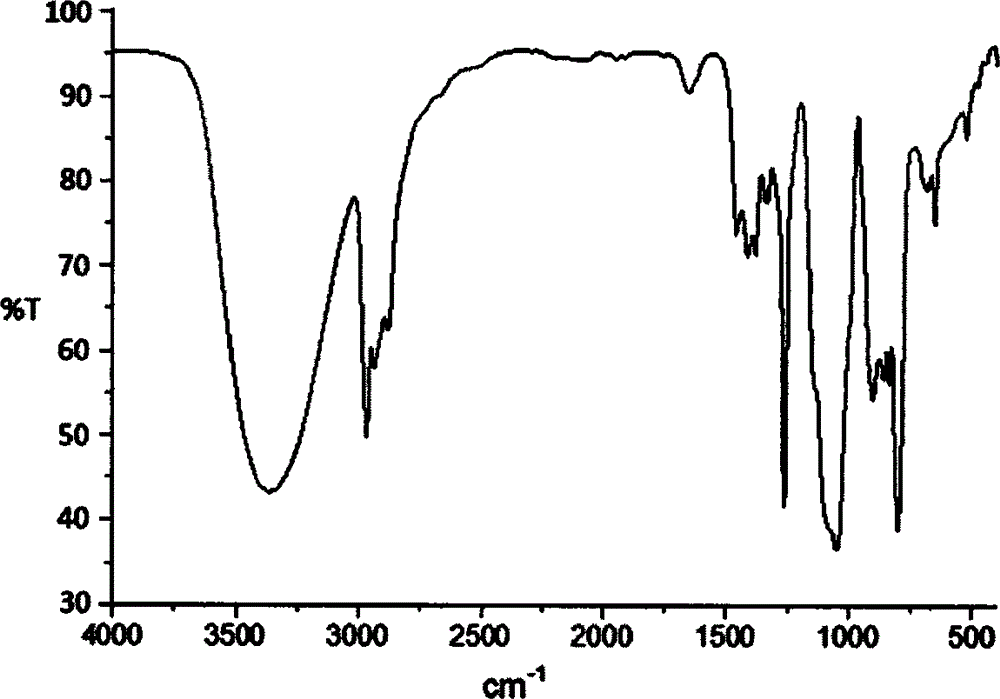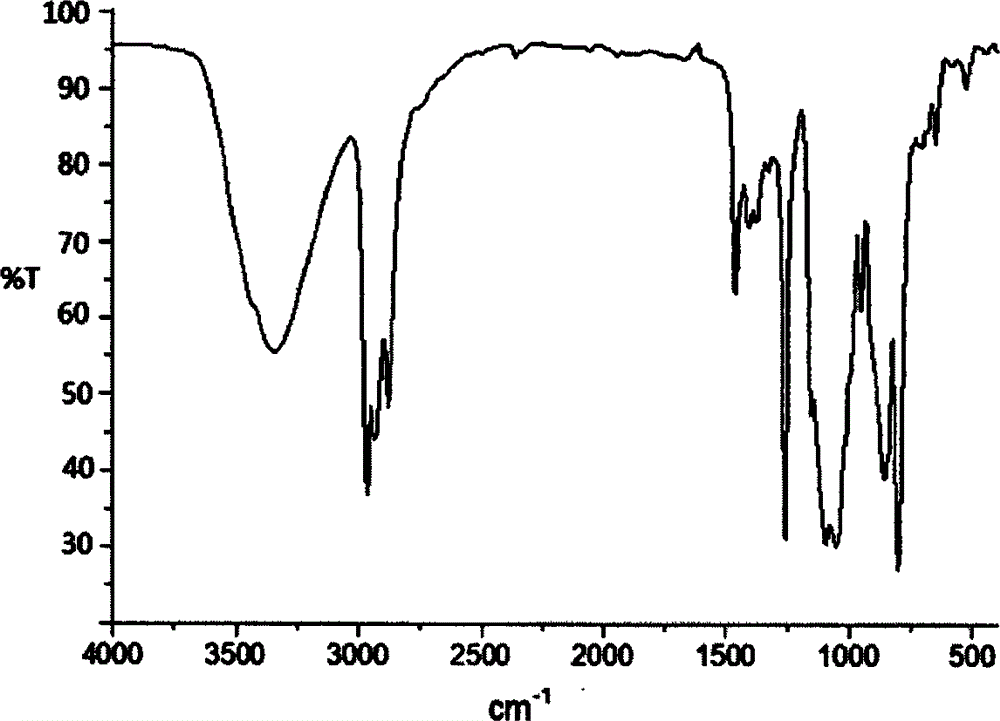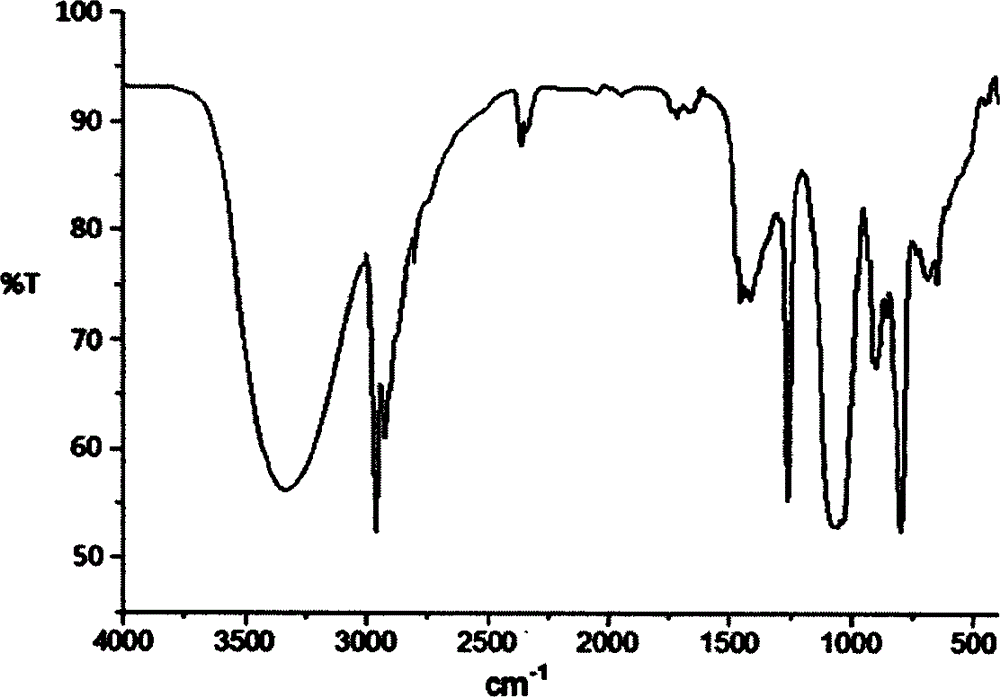Flame retardant 1,2-ortho-diol dimethyl silicate compound and preparation method thereof
A technology of dimethyl silicic acid and o-diol ester, which is applied in the field of flame retardant dimethyl silicic acid-1, can solve problems such as a large amount of hydrogen halide gas, secondary hazards, etc., and achieves good application development prospects and low cost. , the preparation method is simple
- Summary
- Abstract
- Description
- Claims
- Application Information
AI Technical Summary
Problems solved by technology
Method used
Image
Examples
Embodiment 1
[0038] Example 1 In a 100ml four-neck flask equipped with a stirrer, a thermometer, a high-efficiency reflux condenser and a drying tube and a hydrogen chloride absorption device at the upper mouth of the condenser, add 30ml of ethylene glycol dimethyl ether and 7.6g (0.1mol ) 1,2-propanediol, at 20°C, add 12.9g (0.1mol) dimethyldichlorosilane dropwise, the dropwise addition process controls the temperature not to exceed 40°C, after the drop is completed, heat up to 70°C for 1h, and keep the temperature for 8h, Add about 0.4g of triethylamine acid-binding agent, adjust to pH=5-6, stir for 1 hour, filter while hot, distill off the solvent and a small amount of low boiling point from the filtrate to obtain colorless and transparent liquid dimethyl silicic acid-1,2 -Propylene glycol ester, product yield 94.5%, refractive index n D 25 =1.4344, density (25°C) 1.146±0.005g / cm 3 , boiling point 198°C.
Embodiment 2
[0039] Example 2 In the 100ml four-neck flask equipped with agitator, thermometer, high-efficiency reflux condenser and drying tube and hydrogen chloride absorption device at the upper mouth of the condenser, add 50ml dichloroethane and 7.6g (0.1mol) 1 , 2-propanediol, at 20°C, add 12.9g (0.1mol) dimethyldichlorosilane dropwise, and the temperature during the dropwise addition should not exceed 40°C. 0.3g of pyridine acid-binding agent, adjusted to pH = 5-6, stirred for 1 hour, filtered while hot, distilled off the solvent and a small amount of low boiling point from the filtrate to obtain 1,2-propylene glycol dimethyl silicate as a colorless and transparent liquid, Product yield 96.5%, refractive index n D 25 =1.4344, density (25°C) 1.146±0.005g / cm 3 , boiling point 198°C.
Embodiment 3
[0040]Embodiment 3 In the 100ml four-necked flask that stirrer, thermometer, high-efficiency reflux condensation tube are equipped with and drying tube and hydrogen chloride absorption device are equipped with at the top of condensation tube, add 30ml1, 4-dioxane and 7.6g (0.1 mol) 1,2-propanediol, at 20°C, add 12.9g (0.1mol) dimethyldichlorosilane dropwise, the dropwise addition process controls the temperature not to exceed 40°C, after the drop is completed, heat up to 100°C for 2h, and keep the temperature for 5h , add about 0.4g melamine acid-binding agent, adjust to pH = 5-6, stir for 1h, filter while hot, and distill off the solvent and a small amount of low boiling point from the filtrate to obtain colorless and transparent liquid dimethyl silicate-1,2- Propylene glycol ester, product yield 97.2%, refractive index n D 25 =1.4344, density (25°C) 1.146±0.005g / cm 3 , boiling point 198°C.
PUM
| Property | Measurement | Unit |
|---|---|---|
| Boiling point | aaaaa | aaaaa |
| Boiling point | aaaaa | aaaaa |
| Boiling point | aaaaa | aaaaa |
Abstract
Description
Claims
Application Information
 Login to View More
Login to View More - R&D
- Intellectual Property
- Life Sciences
- Materials
- Tech Scout
- Unparalleled Data Quality
- Higher Quality Content
- 60% Fewer Hallucinations
Browse by: Latest US Patents, China's latest patents, Technical Efficacy Thesaurus, Application Domain, Technology Topic, Popular Technical Reports.
© 2025 PatSnap. All rights reserved.Legal|Privacy policy|Modern Slavery Act Transparency Statement|Sitemap|About US| Contact US: help@patsnap.com



